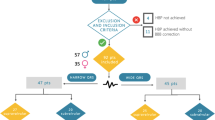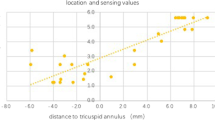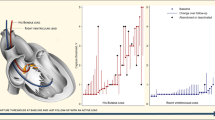Abstract
Purpose
This study aimed to evaluate the utility of a novel pacing guidewire in pre-implantation testing of different left ventricular (LV) sites during cardiac resynchronization therapy (CRT) procedures.
Methods
Ten consecutive patients (8 male, mean age 65.8 ± 4.9) undergoing CRT procedures were studied. Pacing threshold and R-wave sensing measured by the guidewire and LV lead at different LV sites were compared.
Results
Thirty sites (6 apical, 13 middle, and 11 basal; 15 lateral and 15 anterior) were tested. There was significant correlation between pacing threshold (r = 0.878, p < 0.0001), and R-wave sensing (r = 0.896, p < 0.0001) obtained by guidewire and those obtained by LV lead. Separating into lateral and anterior sites, significant correlation was also found in pacing threshold (lateral r = 0.658, p = 0.008; anterior r = 0.886, p < 0.0001) and R-wave sensing (lateral r = 0.887, p < 0.0001; anterior 0.865, p < 0.0001). For basal and middle sites, significant correlation was found in pacing threshold (basal r = 0.890, p < 0.0001; middle r = 0.878, p < 0.0001), and R-wave sensing (basal r = 0.930, p < 0.0001; middle r = 0.823, p < 0.001). No and borderline correlation was found in pacing threshold (r = 0.548, p = 0.26) and R-wave sensing (r = 0.835, p = 0.039), respectively, for apical sites. Concordance rate for the presence of phrenic nerve stimulation at high pacing output was 87%.
Conclusion
The accuracy of the novel pacing guidewire in pre-implantation testing in CRT procedures is site-dependent. There was good correlation with LV lead in the measurement of pacing threshold and R-wave sensing at basal and middle sites, but not apical sites. Presence of phrenic nerve stimulation can be predicted by guidewire testing with high accuracy.

Similar content being viewed by others
References
Abraham, W. T., Fisher, W. G., Smith, A. L., Delurgio, D. B., Leon, A. R., Loh, E., et al. (2002). Cardiac resynchronization in chronic heart failure. The New England Journal of Medicine, 346, 1845–1853.
Bristow, M. R., Saxon, L. A., Boehmer, J., Krueger, S., Kass, D. A., De Marco, T., et al. (2004). Cardiac resynchronization therapy with or without an implantable defibrillator in advanced chronic heart failure. The New England Journal of Medicine, 350, 2140–2150.
Cleland, J. G. F., Daubert, J. C., Erdmann, E., Freemantle, N., Gras, K., Kappenberger, L., et al. (2005). The effect of cardiac resynchronization on morbidity and mortality in heart failure. The New England Journal of Medicine, 352, 1539–1549.
St John Sutton, M. G., Plappert, T., Abraham, W. T., Smith, A. L., Delurgio, D. B., Lean, A. R., et al. (2003). Effect of cardiac resynchronization therapy on left ventricular size and function in chronic heart failure. Circulation, 107, 1985–1990.
Leon, A. R., Abraham, W. T., Curtis, A. B., Daubert, J. P., Fisher, W. G., Gurley, J., et al. (2005). Safety of transvenous cardiac resynchronization system implantation in patients with chronic heart failure: combined results of over 2000 patients from multi-center study program. Journal of the American College of Cardiology, 46, 2348–2356.
Purefellner, H., Nesser, H. J., Winter, S., Schwiertz, T., Hornell, H., & Maertens, S. (2000). Transvenous left ventricular lead implantation with the EASYTRAK lead system: the European experience. The American Journal of Cardiology, 86(9 Suppl 1), K157–K164.
Gurevitz, O., Nof, E., Carasso, S., Luria, D., Bar-Lev, D., Tanami, N., et al. (2005). Programmable multiple pacing configurations help to overcome high left ventricular pacing thresholds and avoid phrenic nerve stimulation. Pacing and Clinical Electrophysiology, 28, 1255–1259.
Ellery, S., Paul, V., Prenner, G., Tscheliessnigg, K., Merkely, B., & Malinowski, K. (2005). A new endocardial “over-the-wire” or stylet driven left ventricular lead: first clinical experience. Pacing and Clinical Electrophysiology, 28, S31–S35.
Debruyne, P. H., Geelen, P., Janssens, L., & Brugada, P. (2003). Useful tip to improve electrode positioning in markedly angulated coronary sinus tributaries. Journal of Cardiovascular Electrophysiology, 14, 415–416.
Chierchia, G. B., Geelen, P., Rivero-Ayerza, M., & Brugada, P. (2005). Double wire technique to catheterize sharply angulated coronary sinus branches in cardiac resynchronization therapy. Pacing and Clinical Electrophysiology, 28, 168–170.
De Cock, C. C., Res, J. C. J., Hendriks, M. L., & Allaart, C. P. (2009). Usefulness of a pacing guidewire to facilitate left ventricular lead implantation in cardiac resynchronization therapy. Pacing and Clinical Electrophysiology, 32, 446–449.
Chan, N. Y., Liem, L. B., Mok, N. S., & Wong, W. (2003). Clinical experience of contrast venography guided axillary vein puncture in biventricular pacing. International Journal of Cardiology, 92(1), 55–58.
Fung, J. W., Lam, Y. Y., Zhang, Q., Yip, G. W., Chan, W. W., Chan, G. C., et al. (2009). Effect of left ventricular lead concordance to the delayed contraction segment on echocardiographic and clinical outcomes after cardiac resynchronization therapy. Journal of Cardiovascular Electrophysiology, 20(5), 536–538.
Leclercq, C., Cazeau, S., Ritter, P., Gras, D., Lazarus, A., Mabo, P., et al. (1997). Permanent biventricular pacing: a new alternative to treat end-stage congestive heart failure? Circulation, 96(Suppl 1), I-95.
Chan, N. Y., & Lo, Y. K. (2007). Impacted left ventricular lead technique in cardiac resynchronization therapy. Europace, 9(7), 531–532.
Kowalski, O., Lenarczyk, R., Prokopczuk, J., Pruszkowska-Skrzep, P., Zielinska, T., Sredniawa, B., et al. (2006). Effect of percutaneous interventions within the coronary sinus on the success rate of the implantation of resynchronization pacemakers. Pacing and Clinical Electrophysiology, 29(10), 1075–1080.
Bleeker, G. B., Mollema, S. A., Holman, E. R., Van de Veire, N., Caudia, Y., et al. (2007). Left ventricular resynchronization is mandatory for response to cardiac resynchronization therapy. Analysis in patients with echocardiographic evidence of left ventricular dyssynchrony at baseline. Circulation, 116, 1440–1448.
Chan, N. Y., Choy, C. C., Cheung, K. C., Lau, C. L., Lo, Y. K., Chu, P. S., et al. (2010). Echocardiographic mapping of left ventricular resynchronization during cardiac resynchronization therapy procedures. Chinese Medical Journal, 123(13), 1645–1651.
Conflict of interest
No financial support or potential conflict of interests to be declared.
Author information
Authors and Affiliations
Corresponding author
Rights and permissions
About this article
Cite this article
Chan, N.Y., Choy, C.C., Lau, C.L. et al. Utility of a novel pacing guidewire in pre-implantation testing at different left ventricular sites in cardiac resynchronization therapy procedures. J Interv Card Electrophysiol 32, 67–71 (2011). https://doi.org/10.1007/s10840-011-9602-0
Received:
Accepted:
Published:
Issue Date:
DOI: https://doi.org/10.1007/s10840-011-9602-0




